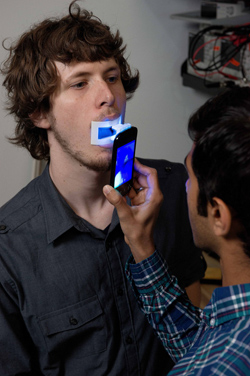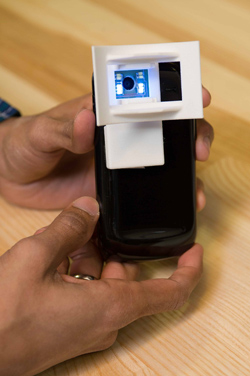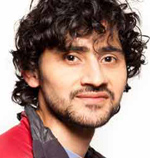April 17, 2012 - By Kris Newby

Stanford medical student Dhruv Boddupalli demonstrates the OScan oral scanner on James Clements, a graduate student of bioengineering, both of whom helped to develop the device.
Thousands of people die needlessly each year in developing countries from oral cancers that could have been detected early with regular dental checkups. But with fewer than one dentist per 100,000 people in many of the world’s rural areas, these checkups are not an option. Now an ultra-low-cost smartphone device being developed at Stanford may enable early diagnosis of these preventable deaths, with no dentist visits required.
Assistant bioengineering professor Manu Prakash, PhD, has developed a way to use smartphones to create detailed images of the oral cavity and screen patients’ mouths for suspicious lesions. The device, which is about the size of a pack of gum, could make it possible for millions of people who live in remote areas to get this imaging done as easily as snapping a photo on a smartphone.
Prakash’s oral cavity scanner, called OScan, consists of a mouth positioner, a circuit board and two rows of fluorescent-light-emitting diodes. It attaches to any smartphone’s built-in camera, and allows an operator — with a quick swipe — to take a high-resolution, panoramic image of a person’s complete mouth cavity. Illuminated by the device’s blue fluorescent light, malignant cancer lesions are easily detected as dark spots. Images can be sent wirelessly to health workers, dentists or oral surgeons for diagnosis, anywhere in the world. The device is designed for mass production, with an estimated material cost of just a few dollars.
The elegant simplicity of OScan, which is in the early phases of testing, was recognized this week with two awards from the Vodaphone Americas Foundation. The OScan team won first and second place, respectively, for the mHealth Alliance Award and the Vodaphone Americas Foundation Wireless Innovation Project. Prakash and the OScan development team plan to use the $250,000 in award money to do more field testing of the device and software application in India.
The seeds of OScan were sewn when Prakash stopped by a rural clinic while on vacation in Sevagram, India. A medical student there showed him biopsy slides of oral cancer patients, and what he saw was shocking. Slide after slide showed the devastating effects this type of cancer has on the clinic’s patients. Many had inoperable, malignant lesions on the tongue and cheek, with some patients being as young as 15. Although oral cancer has a high survival rate if caught early, two-thirds of the patients who walked into the clinic were too late for treatment.

OScan is an ultra-low-cost imaging tool for the oral cavity that attaches to any smartphone’s camera, allowing untrained individuals to affordably screen for oral cancer.
“Sometimes I see a problem and it just sticks in my head. This was one of those moments for me,” said Prakash. “I just could not walk away from that chance meeting. I knew friends at high school who used to chew tobacco constantly. Nobody talked about the dire consequences.”
Prakash, a prolific inventor, went to work on the problem after he moved to Stanford from the MIT Media Lab last summer. Within a few months, he and his team — which includes James Clements, a first-year graduate student of bioengineering; Dhruv Boddupalli, a Stanford medical student; and Aditya Gande, a student from Cupertino High School — built a prototype scanner and took it to India for field testing.
Oral cancer is the most common cancer in India, Pakistan, Sri Lanka and other parts of South Asia. Although oral cancer stands as the sixth-most frequent type of in United States, it accounts for more than 40 percent of cancer-related deaths in India, not surprising considering that nearly 57 percent of males and 11 percent of women consume tobacco in that country.
In India alone, tobacco products other than conventional cigarettes account for 80 percent of the total tobacco consumption. Half is sold as bidis, tobacco rolled in tendu leaves without filters. A bidi delivers 10 times more tar and carbon monoxide than traditional cigarettes. The other half is sold as chewing tobacco, called gutka, which is often marketed in child-friendly packaging as mouth freshener or gum. Gutka is mixed with abrasive chunks of areca nut, and this accelerates the negative effects of nicotine and cancer-causing chemicals.
Prakash’s approach to addressing the oral cancer problem involves hardware, infrastructure and educational components. With the help of the Vodaphone funding, the team will collaborate with partners in the field to refine the OScan design, addressing issues such as durability, usage and local manufacturing.

Manu Prakash
“Our team’s field trips are invaluable in refining ideas and seeing what will work in a given context,” said Prakash. “The feedback we got from surgeons who see patients every day, and from cancer screening clinics in rural parts of South India, shaped the project. I am always inspired by the energy of rural health workers in the field and I am thankful for the current support so we can continue this transition from technology development to field deployment.”
For the infrastructure component, his team will be working to define delivery models for OScan services. A major obstacle to oral cancer screening in India is the scarcity of dentists, who are often the first to spot oral cancer lesions. With only one dentist for every 250,000 residents in rural India and no tradition of regular dental checkups, this will be a major barrier to OScan adoption.
With the support of the mHealth Alliance, Prakash hopes to develop partnerships with wireless service providers and health insurance providers to explore ways to offer checkups and tobacco-use education in these resource-strapped regions.
Vodaphone Americas Foundation launched the Wireless Innovation Project in 2009 to make an impact on pressing global problems through innovative wireless solutions. Prakash’s team won the second place award of $200,000 in this category. They were also named the mHealth Alliance Award winner, which comes with an additional $50,000 and networking support from the mHealth Alliance, an organization dedicated to enabling the use of mobile technologies to improve health throughout the world. The team traveled to Washington D.C. on April 17 to accept their awards at the Global Philanthropy Forum.
The Vodaphone Americas Foundation is one of a family of foundations established by Vodaphone, a multinational telecommunications company with headquarters in London.
The OScan project was funded by the Wallace H. Coulter Foundation, which supports the translation of ideas that address unmet medical needs into treatments and devices that improve human health. Stanford University has filed for a patent on this technology.
_________________________________________________________________
Kris Newby is the communications manager for Spectrum, the Stanford Center for Clinical and Translational Education and Research.
About Stanford Medicine
Stanford Medicine is an integrated academic health system comprising the Stanford School of Medicine and adult and pediatric health care delivery systems. Together, they harness the full potential of biomedicine through collaborative research, education and clinical care for patients. For more information, please visit med.stanford.edu.